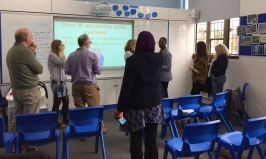Prologue: I asked my GCSE German teacher if she would tell me my mock grade before our lesson. I cannot believe how well she said I had done! I got a 9! Yay!
– – – – –
We are at the end of an unprecedented period of reform for GCSEs. It is still unclear exactly the level of challenge reformed qualifications and assessments give a pupil, nor are we yet able to predict with any certainty where grade boundaries might be set. At GCSE the grade 9 was to be reserved for only the very highest performances. Tim Leunig, then chief scientific advisor of the Department for Education, ‘guessed’ on Twitter in 2017 that only two pupils in the UK would achieve a clean sweep – straight grade 9s in all of their GCSEs – once the qualifications had swapped to number grades (Leunig, 2017). A more scientific approach to this estimate was conducted by Cambridge Assessment in the excellent article by Tom Benton in the run up to the summer 2018 exam session. It was predicted that:
- Of pupils taking eight GCSEs, between 200 and 900 candidates will achieve straight 9s.
- Of pupils taking ten GCSEs, between 100 and 600 candidates will achieve straight 9s.
(Benton, 2018)
Nationwide this means we are potentially looking at a very small number in contrast to the familiar newspaper stories of huge swathes of pupils at the most selective schools achieving a clean sweep of A*s. It is therefore unfair to expect a raft of pupils to achieve straight 9s in the summer. Are your school leaders aware that there is a possibility only 100 pupils will achieve ten 9 grades this summer? If not show them Tom’s article in all its glory, it really is a thing of beauty.
So how many students actually achieved straight 9s in the 2018 results? A good question! Dave Thomson at the Education Data Lab has written a far better blog than the one you are reading that answers it (Thomson, 2018). He points us to Ofqual’s official guide to the 2018 data, which looked at pupils who took at least seven reformed GCSEs; only 732 achieved a grade 9 in all of their GCSEs; of this number 62% were female and 38% male (Ofqual, 2018). Do you think this data should be something your school knows about? If you think so send them a link to Dave’s wonderful blog.
The overall picture is that the new GCSE qualifications are purposefully tough – the new “gold standard” according to the DfE (Hansard, 2019) – but still in their infancy. The more data that is formally collected and analysed, the better we can evaluate the new qualifications. It is certainly clear that comparisons to pre-2018 data will be tricky if not actively unhelpful. Yet you can be sure that there will be an unhealthy focus in some quarters on achieving ‘clean sweeps’. To end the post and counteract this tunnel vision I would like to bring attention to this quote from Tom Benton:
“Regardless of whether the predictions [of how many pupils will achieve straight 9 grades] are right or wrong, one thing is clear: achieving grade 9 in any GCSE subject is hard. Congratulations to all those students who achieve it in any subject at all.”
(Benton, 2018)
– – – – –
Epilogue: I asked my A Level Spanish teacher if he would tell me what my UCAS prediction was. I am so disappointed. I really feel I can do better than a C. It’s not fair 😦
– – – – –
References:
- Leunig, T (2017) “2 is my guess – not a formal DfE prediction. With a big enough sample, I think someone will get lucky…” Tweeted 25th March 2017. Accessed 10th June 2019. View here.
- Benton, T (2018) How many students will achieve straight grade 9s in reformed GCSEs? Accessed 10th June 2019. View here.
- Thomson, D (2018) GCSE results 2018: How many grade 9s were awarded in the newly reformed subjects? Accessed 10th June 2019. View here.
- Ofqual (2018) Guide to GCSE results for England, 2018. Accessed 10th June 2019. View here.
- Hansard (2019) IGCSE: Written question 231357, answered on 19th March 2019. Accessed 10th June 2019. View here.
- Prologue and Epilogue ‘jokes’ the work of the author of this blog post. Sorry!



 This year sees the third
This year sees the third 

 surmises that the most effective teachers ask pupils to explain how they answered a question, honing in on the thought process rather than just the final answer. Come and join us to question questioning itself. It is the delegates that really make the conference so worthwhile; I do hope you might consider coming along and experiencing SASFE for yourself.
surmises that the most effective teachers ask pupils to explain how they answered a question, honing in on the thought process rather than just the final answer. Come and join us to question questioning itself. It is the delegates that really make the conference so worthwhile; I do hope you might consider coming along and experiencing SASFE for yourself.










